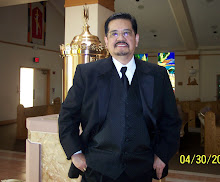The headache and pang for sleep disappears once the lover is face to face with the beloved.
That is exactly how a faithful feels during the hours between an Easter Vigil and the "Salubong," a Philippine Catholic tradition.
So last Holy Saturday, from 9 p.m. , we attended the Easter Vigil celebration at our parish in San Andres Apostol which lasted almost three hours, close to midnight. Then we went home and barely two hours after, woke up to attend the 3 a.m. "Salubong"procession.
Others in the parish church didn't have a wink or two. Members of the Knights of Columbus Council 15419, for instance, acting as marshalls for the entire Holy Week celebrations, kept watch over the statues and icons which were to be used for the "Salubong."
The "Salubong," is a re-enactment of a scene in which the Blessed Virgin Mary, mourning for the death of her son, met up with the Risen Lord.
It is a joyous occasion, a VICTORY!
 |
| The Blessed Mother about to meet her Beloved Son |
 |
| The Risen Lord anticipates the appearance of the Virgin Mother |
 |
| The glorious event, the "Salubong," or meeting up |
 |
| The Mother is reunited with the Risen Christ |
Unique to the Philippines and countries colonized by Spain during the colonization years, the "Salubong," is re-enacted in churches throughout the Philippines.
In a "Salubong," there are two starting points. One, wherein the Blessed Mother, accompanied by women faithfuls leaves a church courtyard or another place within the parish, and a second spot, wherein the Risen Lord, accompanied by the male faithfuls originates.
At a given point, the two central characters would meet up, a "Salubong," literally a converging point.
According to the Jesuit Gourmet, Fr. Joel Liwanag, " this is not written in the Bible, but the Filipinos' natural affinity to their mothers tell them that if there is someone to whom Christ will show himself first after his resurrection, it must be to his mother who loved him so much. This explanation is quite reasonable. St. Ignatius himself seems to have the same logic in his Spiritual Exercises (SpEx) when he highlighted this event by making it first among the contemplations of the Fourth week of the Exercises. He writes, "rising again, he appeared in body and soul to his Blessed Mother" (SpEx [219]). He explained that, "Although this is not stated in Scripture, still it is considered as understood by the statement that he appeared to many others." (SpEx [299])."
 |
| A full moon guides the "Salubong" |
 | ||||
| Fr. Vic of San Andres Apostol Parish, celebrates Easter mass, March 31, 2013 in an open field |

A mass has been celebrated at the meet up point at about 4:30 in the morning, and before 6 a.m., the congregants headed back to Church in a procession.
 |
| The Easter procession passes through the streets of the village |
 |
| It's Glorious Easter, a festive occasion, called Pasko ng Pagkabuhay in the Philippines, so a marching band joins the faithful in the celebration |
 | |||
| The Risen Lord heads back to Church after the "Salubong" |
HAPPY EASTER 2013 TO EVERYONE.




























